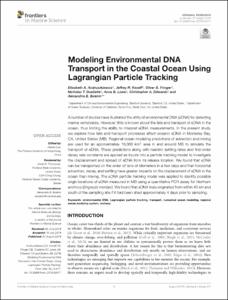| dc.contributor.author | Andruszkiewicz, Elizabeth A. | |
| dc.contributor.author | Koseff, Jeffrey R. | |
| dc.contributor.author | Fringer, Oliver B. | |
| dc.contributor.author | Ouellette, Nicholas T. | |
| dc.contributor.author | Lowe, Anna B. | |
| dc.contributor.author | Edwards, Christopher A. | |
| dc.contributor.author | Boehm, Alexandria B. | |
| dc.coverage.spatial | Monterey Bay | en_US |
| dc.date.accessioned | 2023-05-20T14:08:50Z | |
| dc.date.available | 2023-05-20T14:08:50Z | |
| dc.date.issued | 2019 | |
| dc.identifier.citation | Andruszkiewicz, E.A., Koseff, J.R., Fringer, O.B., Ouellette, N.T., Lowe, A.B., Edwards, C.A. and Boehm, A.B. (2019) Modeling Environmental DNA Transport in the Coastal Ocean Using Lagrangian Particle Tracking.
Frontiers in Marine Sciences, 6:477, 14pp. DOI: 10.3389/fmars.2019.00477 | en_US |
| dc.identifier.uri | https://repository.oceanbestpractices.org/handle/11329/2227 | |
| dc.description.abstract | A number of studies have illustrated the utility of environmental DNA (eDNA) for detecting
marine vertebrates. However, little is known about the fate and transport of eDNA in the
ocean, thus limiting the ability to interpret eDNA measurements. In the present study,
we explore how fate and transport processes affect oceanic eDNA in Monterey Bay,
CA, United States (MB). Regional ocean modeling predictions of advection and mixing
are used for an approximately 10,000 km2 area in and around MB to simulate the
transport of eDNA. These predictions along with realistic settling rates and first-order
decay rate constants are applied as inputs into a particle tracking model to investigate
the displacement and spread of eDNA from its release location. We found that eDNA
can be transported on the order of tens of kilometers in a few days and that horizontal
advection, decay, and settling have greater impacts on the displacement of eDNA in the
ocean than mixing. The eDNA particle tracking model was applied to identify possible
origin locations of eDNA measured in MB using a quantitative PCR assay for Northern
anchovy (Engraulis mordax). We found that eDNA likely originated from within 40 km and
south of the sampling site if it had been shed approximately 4 days prior to sampling. | en_US |
| dc.language.iso | en | en_US |
| dc.rights | Attribution 4.0 International | * |
| dc.rights.uri | http://creativecommons.org/licenses/by/4.0/ | * |
| dc.subject.other | Environmental DNA | en_US |
| dc.subject.other | Lagrangian particle tracking | en_US |
| dc.subject.other | Numerical ocean modeling | en_US |
| dc.subject.other | Ocean transport | en_US |
| dc.title | Modeling Environmental DNA Transport in the Coastal Ocean Using Lagrangian Particle Tracking. | en_US |
| dc.type | Journal Contribution | en_US |
| dc.description.refereed | Refereed | en_US |
| dc.format.pagerange | 14pp. | en_US |
| dc.identifier.doi | https://doi.org/10.3389/fmars.2019.00477 | |
| dc.subject.parameterDiscipline | Other biological measurements | en_US |
| dc.subject.parameterDiscipline | Biota composition | en_US |
| dc.bibliographicCitation.title | Frontiers in Marine Science | en_US |
| dc.bibliographicCitation.volume | 6 | en_US |
| dc.bibliographicCitation.issue | Article 477 | en_US |
| dc.description.sdg | 14.a | en_US |
| dc.description.maturitylevel | Pilot or Demonstrated | en_US |
| dc.description.methodologyType | Method | en_US |
| dc.description.methodologyType | Reports with methodological relevance | en_US |
| obps.contact.contactname | Alexandria B. Boehm | |
| obps.contact.contactemail | aboehm@stanford.edu | |
| obps.resourceurl.publisher | https://www.frontiersin.org/articles/10.3389/fmars.2019.00477/ | |
 Repository of community practices in Ocean Research, Applications and Data/Information Management
Repository of community practices in Ocean Research, Applications and Data/Information Management

